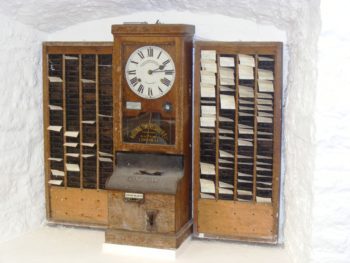On March 9, Elena Fernández, a Marie Curie Post-Doctoral Researcher at the University of Zurich and NULab Virtual Visiting Scholar, gave a presentation about her ongoing research on the role of technology in the processes of modernization and globalization. Using a large database of newspaper articles, blogs, and other mass media big data along with computational research methodologies, Fernández’s research agenda is to deconstruct the effect of technology in the processes of globalization.
Early in the presentation, Fernández briefly discussed her journey into computational methods which began when she was doing her graduate degree in Spanish Language and Literature and specialized in qualitative scholarship. Eventually, she discovered the richness of big data analysis tools, like Python and computational text analysis, and saw the potential that tools such as these had in unraveling the patterns that would be inaccessible with only qualitative methods. She relied on these methods in order to deconstruct foreigners’ views of Spain and how the increase in Spanish stereotypes, in particular, triggered the formation of national identity in peninsular Spain throughout the 19th century. In the context of Northern European imperialism when anti-Southern European propaganda began to gain traction against the background of declining Southern European empires—of which Spain was one—Northern European empires began to resort to national stereotypes. Fernández’s theoretical framework at the time was centered around the idea of how prototypes that humans develop in order to make sense of social reality eventually turned into stereotypes, especially during the processes of national identity formation. Although Fernández’s research has moved away from this topic, she retained her theoretical training.

Fernández then discussed her current research about the social construction of time and the ways in which globalization and capitalism alter our perceptions of time. For instance, prior to the discovery of electricity, work days revolved around the actual movements of the sun, with the end of a typical work day coinciding with the sunset. However, the standard work day was reconfigured dramatically with the widespread dissemination of electrical power. The 19th century, in particular, experienced a dramatic increase in the number of technological advancements and inventions that have profoundly transformed our sense of time. Fernández was interested in the shift from periodizing the eras in terms of centuries (e.g. “the long 19th century”) to marking them in accordance with decades (e.g. “the roaring twenties). But how do you measure this shortening of the periodization of history using computational quantitative methods? Fernández argues that newspapers, to a large extent, can support quantitative research in this domain. Though by no means the perfect measure, newspapers do capture the changes in public attitudes, perceptions and opinions over time. Quantitative narrative analysis which isolates narrative units and turns them into quantifiable units, known as subject-verb-object (SVO) triplets, was one of the methods Fernández and her colleagues relied on during their research on the subject. The increase in SVO triplets that they found indicates that, indeed, throughout the late 19th century and into the early 20th century and onward, people in Spain were doing more things in the same amount of time while information variety had expanded considerably. This finding confirmed her hypothesis about the changes in the perceptions of time and a considerable shortening of the periodization of history.
Fernández, reflecting back on her earlier research on culture and stereotypes, is currently interested in exploring whether cultural narratives around technology and time have homogenized across Spain, the US, the UK and continental European countries. Fernadez is also interested in documenting the degree to which technological and economic breakthroughs at the scale of the Industrial Revolution and, most recently, the digital revolution, are causing an increase in the rates of anxiety and fear of the future. Broadly speaking, Fernández is also interested in public opinion on technology and technological change and hopes that computational sentiment analysis of public opinion on new technologies such as railroads, coal, and the Internet at the time of their invention, can capture people’s anxieties about the impact of these innovations on their future. Fernández is also interested in investigating whether there is a geographical variation in this trend or, perhaps, the opposite—that technology is homogenizing people’s perceptions of time, space, and visions of the future.
The meeting was followed by a Q&A session during which Fernández was asked to elaborate on the pragmatics of conducting a multilingual analysis. Fernández noted that while her own skills, such as high proficiency in both English and Spanish, are certainly an asset, she relies on collaborations with other researchers. Fernández then discussed a few potential limitations of her research, such as the degree to which her sample of newspapers and other data was representative enough. She also discussed a few alternative methods to measuring the changes she has captured and cautioned against using the findings to predict how people will react to future technological changes. Fernández and the audience then concluded the talk by agreeing that, ultimately, research in digital humanities does not seek to predict the future. Rather, the goal is to provide an informed speculation about how people will likely process and adapt to the changes that are to come.
Image credits: Image 1 – Wikimedia Commons here. Image 2 – Wikimedia Commons here.
For further questions or for more information, please contact Yana Mommadova at mommadova[dot]y[at]northeastern[dot]edu



